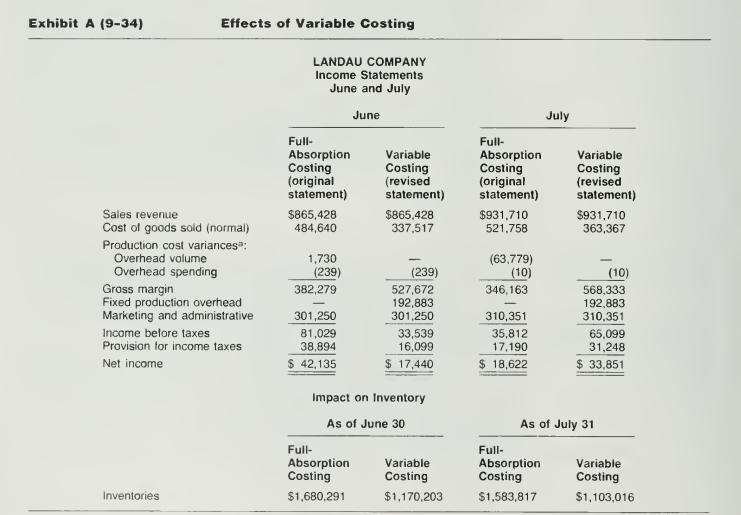Comprehensive Case on Choosing Full-Absorption or Variable (Normal) Costing Landau Company : In early August, Terry Silver,
Question:
Comprehensive Case on Choosing Full-Absorption or Variable (Normal) Costing Landau Company : In early August, Terry Silver, the new marketing vice president of Landau Company, was studying the July income statement. Silver found the statement puzzling: July's sales increased significantly over June's, yet income was lower in July than in June. Silver was certain that margins on Landau's products had not narrowed in July and therefore felt that there must be some mistake in the July statement.
When Silver asked the company's chief accountant, Meredith Wilcox, for an explanation. Wilcox stated that production in July was well below standard volume because of employee vacations. This had caused overhead to be underapplied, and a large unfavorable volume variance had been generated, which more than offset the added gross margin from the sales increase. It was company policy to charge all overor underapplied overhead variances to the monthly income statement, and these production volume variances would all wash out by year's end. Wilcox had said.
Silver, who admittedly knew little about accounting, found this explanation to be "Incomprehensible. With all the people in your department. I don't understand why you can't produce an income statement that reflects the economics of our business. In the company that I left to come here, if sales went up. profits went up. I don't see why that shouldn't be the case here, too."
As Wilcox left Silver's office, a presentation at a recent National Association of Accountants meeting came to mind. At that meeting, the controller of Winjum Manufacturing Company had described that firm's variable costing system, which charged fixed overhead to income as a period expense and treated only variable production costs as inventoriable product costs. Winjum's controller had stressed that, other things being equal, variable costing caused income to move with sales only rather than being affected by both sales and production volume, as was the case with full-absorption costing systems.
Wilcox decided to recast the June and July income statements and balance sheets using variable costing. (Both the original and the revised income statements and related impact on inventories are shown in Exhibit A.) Wilcox then showed these statements to Terry Silver, who responded, "Now that's more like it! I knew July was a better month for us than June, and your new 'variable costing' statements reflect that. Tell your boss (Landau's controller] that at the next meeting of the executive committee I'm going to suggest we change to this new method."

At the next executive committee meeting. Silver proposed adoption of variable costing for Landau's monthly internal income statements. The controller also sup- ported this change, saying that it would eliminate the time-consuming efforts of allocating fixed overhead to individual products. These allocations had only led to arguments between operating managers and the accounting staff. The controller added that since variable costing segregated the costs of materials, direct labor, and variable overhead from fixed overhead costs, management's cost control efforts would be enhanced. Silver also felt that the margin figures provided by the new approach would be more useful than the present ones for comparing the profitability of individual products. To illustrate the point, Silver had worked out an example. With full- absorption costing, two products in Landau's line, numbers 129 and 243, would appear as follows:

Thus, Product 243 would appear to be the more desirable one to sell. But on the proposed basis. the numbers were as follows:

According to Silver, these numbers made it clear that Product 129 was the more profitable of the two.
At this point, the treasurer spoke up. "If we use this new approach. the next thing we know, you marketing types will be selling at your usual markup over variable costs. How are we going to pay the fixed costs then? Besides, in my 38 years of experience, it's the lack of control over fixed costs that can bankrupt a company. I'm opposed to any proposal that causes us to take a myopic view of costs."
The president also had some concerns about the proposal. "In the first place, if 1 add together the June and July profit under each of these methods. I get almost $61,000 with the full-absorption method, but only $51.000 under the variable costing method. While I'd be happy to lower our reported profits from the standpoints of relations with our employee union and income taxes, I don't think it's a good idea as far as our owners and bankers are concerned. And I share Sam's [the treasurer's] concern about controlling fixed costs. I think we should defer a decision on this matter until we fully understand all of the implications."
Required:
a. Critique the various pros and cons of the variable costing proposal that were presented in the meeting. What arguments would you add?
b. Do you think Landau should adopt variable costing for its monthly income statements?
Step by Step Answer:






